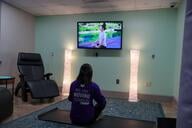You have /5 articles left.
Sign up for a free account or log in.

Kitchen West
University of North Texas
Students at the University of North Texas are about to be able to eat a lot safer.
UNT has opened a new all-you-can-eat dining hall free of the “Big 8” food allergens, the second in the nation.
The Big 8 of allergens includes eggs, fish, milk, peanuts, shellfish, soy, tree nuts and wheat. Ninety percent of food allergy reactions occur to one of these foods. In allergen-free dining halls like these, food is prepared with equipment and ingredients that never come into contact with the common allergens.
“There is an identified need for people to have access to food that is free of the Big 8 allergens,” said Peter Balabuch, executive director of UNT Dining Services, which serves between 9,000 and 11,000 meals a day in resident dining alone.
“This is a very forward-thinking move,” said Kristi Grim, the director of national programs at Food Allergy Research & Education. “Not all that common yet, but because of the increasing prevalence, we are seeing more and more students requesting these accommodations.”
Grim said that at FARE they hear all the time that college students are increasingly living with food allergies.
UNT’s Kitchen West will serve the typical cafeteria fare as well as boasting a menu of beef tacos, vegan korma, meatballs, eggplant parmesan and Creole cuisine. Kitchen West's meals can be covered by student's meal plans or purchased by guests for $5.50 plus tax, which is a lower price point than most other dining halls on campus. The improved dining hall can fit 170 diners.
“I think that people are more conscious and more aware of ingredients over all,” said Balabuch, who has seen that many students are speaking up about what they need from a culinary standpoint. Balabuch said that a smaller percentage of people have actual allergies compared to the larger numbers that are more aware of what they are putting in their bodies.
Between 1997 and 2007, the number of young people with food allergies jumped 50 percent. Many of those young people are college age now. Approximately 32 million Americans have food allergies, including over 26 million adults. Forty percent of children with food allergies are allergic to more than one food.
The university was already clearly labeling food with allergens but decided to take the next step. Kitchen West also got a facelift to be more light and modern and now has educational signs throughout teaching diners about Big 8 allergen awareness.
UNT put in almost a year of planning and recipe testing.
“Spring semester our chefs gathered recipes and looked at different types of concepts that were allergen-free,” Balabuch said. “A lot of the samplers were students on the UNT campus that were resident advisers.”
About once a year UNT’s dining services has to replace cookware and dishes, and this year they put more emphasis on Kitchen West by doing a complete overhaul. They did a deep dry steaming to sanitize equipment and bought brand-new dishes and cookware.
“Because we’re starting from whole ingredients like we do in our other dining halls, there aren’t any major cost differences for allergen-free recipes,” said Balabuch. “We aren’t purchasing costly, highly processed alternative products. And we won’t purchase, for instance, cornmeal, if it was prepared in a facility where other allergens are present. We are committed to starting from scratch just like we do in our other four dining halls, which allows us to ensure great quality and affordability for our students.”
UNT is not the first university to take the extra precautions. Michigan State University opened a similar dining hall earlier this summer.
Thrive, the Big 8-free dining hall at Michigan State, was a product of months of careful planning by the university from January to July.
Previously the university provided for students with allergies by offering stations dedicated to food restrictions, and built-to-order options that offered substitutions or alternatives for certain ingredients.
At Michigan State roughly one in eight students has some sort of dietary restriction.
Thrive offers lunch and dinner from Monday to Friday for 600 to 700 people a day, averaging around 3,000 meals a week. There are three stations at Thrive: Grid, which offers street food-inspired cuisine; Pantry, which has home-style comfort food; and a regular cafeteria fare option.
“I’ve been able to have the opportunity to talk to several people that have said they were toggling between two different schools and this is what took them over the edge of ‘I’m definitely picking Michigan State,’” said Gina Keilen, a dietitian with Culinary Services at Michigan State and the project manager for Thrive.
Keilen said she watched the trend over the last few years of more and more students and guests wanting alternatives. She said Thrive makes dining at Michigan State attractive to guests.
At first Culinary Services considered just one station rather than three for Thrive, but Keilen didn’t want the risk of cross-contamination or having to have two separate storage rooms.
Every ingredient is checked by Keilen and the chefs and is also approved by a third-party auditor, Kitchens With Confidence, to ensure safety.
Keilen said that everyone on her staff has “come on board in a great way,” and that seeing the impact Thrive has on students has them excited about their work. “People [are] literally crying in front of them” because of their new options, Keilen said.
“It never really crossed our mind not to do the Big 8 plus gluten, never a thought not to,” said Keilen. “It made sense for us to go whole hog with it and get rid of those nine restrictions.” Keilen said that she’s been reached out to by others who plan on going in a similar direction and are using Thrive as a resource.
Both universities have heard overwhelmingly positive responses from their communities.
Grim said that students with food allergies just want to fit in and don’t want to be excluded, but they also don’t want to make a big deal out of their restrictions.
“These types of dining halls allow students to have these bonding experiences,” Grim said. “They really want to just live their life. In a perfect world, a student could pick a university without ever having to think about their food. You also have to live safely on campus -- a degree does you no good if you can’t live safely on campus.”
“From the standpoint of how they're looking at the food, people have really given us good feedback on how the food tastes,” said Balabuch. “It's less about the absences of these allergens.”
Balabuch said he received letters from parents that expressed appreciation for this move, and that students with allergies now feel a sense of freedom. He was able to meet with parents of students with dietary restrictions who connected him with resources and practices that worked for the parents at home.
At Michigan State, Culinary Services has worked with the Resource Center for Persons with Disabilities to ensure that all students with restrictions can eat.
“One of the things that is often missing from this conversation is moving beyond the dining hall,” said Grim about what more universities can do. “Not just the responsibility of the dining hall. They need to think about other places on campus.”
Food shows up in classrooms and at residence hall activities, and Grim said that training resident advisers on how to safely incorporate food into programming is one step universities can take. Education on what anaphylaxis can look like is also beneficial, because sometimes symptoms can lead onlookers to believe the student simply drank too much.
“There isn’t really one correct way to accommodate students with food allergies,” Grim said, noting that at FARE they avoid saying something is completely allergen-free because there are always going to be people on those campuses that are going to be allergic to something offered.
Because of this, Grim said that universities should work with individual students to find additional steps that work for them, such as exemptions to meal plans.
“Your food-serving establishment is really only as good as your employees,” Grim said.




